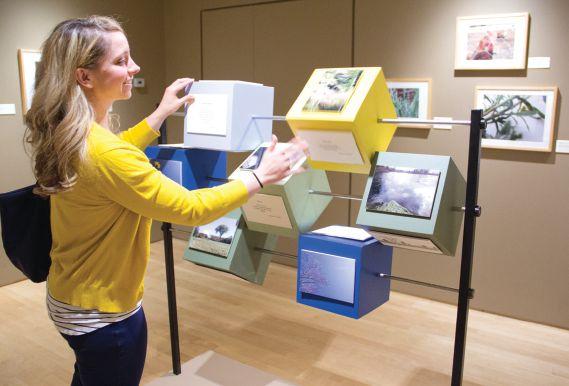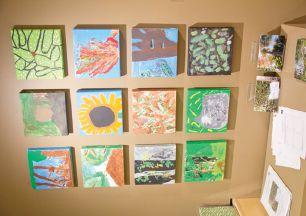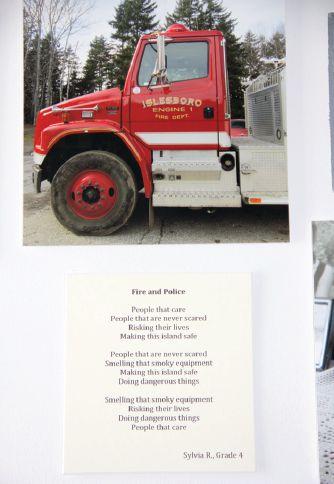
4 minute read
Lens on Learning
Making Art more than a “Special”
With cameras in hand, students at six Midcoast schools work to capture a story they’ll later tell with pictures and words, being creative outside of the 45 minutes of art class they may receive each week.
“Every year a teacher says, this student doesn’t participate in class, but he loves doing this,” said Andrea Curtis, Art-in-Education Project Manager at the Farnsworth Art Museum.
The Farnsworth, in the center of Rockland, works with 300 students and their teachers in a year-long arts-integrated school initiative to tell the stories of their community through art in a project called Stories of the Land and its People.
Stories of the Land was organized so that students in grades 4 and 7 could learn from their teachers (specialty and classroom), museum professionals, and mentor artists about how to use the arts— especially digital photography—in their studies of English Language Arts, History, Social Sciences and other disciplines. For example, students may take pictures of the people who work where they live doing diff erent jobs and then share a poem about that person, integrating the art of photography with English.
“I remember one father saying that he read a poem about a picture his son took and he said to me ‘I didn’t know my son had this in him.’ We’re really moved by how we’re reaching out to these communities. It’s their museum,” said Roger Dell the museum’s Director of Education.
The Farnswoth Art Museum’s Andrea Curtis, Art-in-Education Project Manager and Roger Dell, Director of Education
“If we’re going to have a creative workforce, then creativity must be mirrored for our students by teachers and visiting artists. We’re trying to work with teachers to bring art to bear
upon all of their subjects.” - Roger Dell
Students connected to their photographs in many ways, including poetry writing, creative writing, natural science research, and math lessons with hands-on displays at the museum.



Stories of the Land and Its People is truly an amazing project. We are so incredibly lucky to have such generous supporters (donors) of the project and the leadership and support of Roger and Andrea.
This project is extremely engaging! It makes teaching and learning fun! It naturally encourages differentiated learning, so it allows all my students to fi nd success. It's hard for me to admit this, but the arts are scary. I don't consider myself an artistic person. My mom normally comes into my classroom to do my holiday projects! This project has taught me a lot, but one of the most important things I've learned is that I don't need to be the expert on everything. I just need to open my doors. The Farnsworth brings the experts to us and often I'm learning right along with my students. It's such a collaborative effort. To top it off, the fi nal exhibition brings together all of our families, so it's a perfect example of the power that schools, families, and the community have when they work and celebrate together! It's made me a better teacher. Wendy Jacques, South School, Grade 4 Teacher (Seacoast EA)
I think the benefi t that stands out to me the most, outside of it bringing the arts into our classroom, is Stories of the Land and its People encourages “place-based learning.” I think students tend to enjoy and retain the learning about something that they can see, feel, and/or witness so much more than through long lectures and readings. This program offers them the opportunity to experience and be a part of the topic learning through their photography. It gives a sense of importance to the topic because they can relate or connect to it once they begin photographing it. Research and writing on the topic becomes linked to their own background knowledge and each student can relate to the topic more completely and with equal opportunity.
Andrea, from the Farnsworth Art Museum, knows how to question and encourage deeper thinking in students when talking about pieces of art. She's modeled this process over the years with my students, thus giving me the opportunity to “pick up” on it and use in my own teaching. Critical and deeper thinking skills are skills that all may benefi t from these days. Coral Coombs, Lincolnville Central School, Grade 4 Teacher (Lincolnville EA)

Children need to have a reason to learn to read and do mathematics. To engage with material from another time or learn about how photos of Pluto were taken and transmitted lifts them into their own futures. I think schools should be places where students glimpse what is ahead for them, and where they can get excited about this incredible world in which we all live. This is the function of studying the arts and humanities.
My students are very excited to be photographers through this arts-integrated project. They won't consider missing a fi eld experience if they will have the cameras. Along the way vocabulary, for example: vantage point, simplicity/complexity, color/contrast, shade, shadow, brightness, close up, detail, foreground, background, shapes, and size help with writing assignments because students not only have words to describe and compare what they want to say, but they have learned to point with their words while studying a work of art.
As a teacher, I fi nd myself encouraging “deep noticing” as a means of allowing students to think about a passage in reading, a diffi cult phrase to decipher in a math problem, or as a way of comparing objects or photos in science or social studies. Gail Boukary, South School, Grade 4 Teacher (Seacoast EA)











